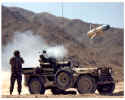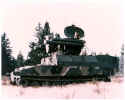1981
FY 81 Phase-out of the SHILLELAGH/M60A2 system from active Army units was completed.
FY 81 The RASA Flight Operations Division received the DA Aviation Accident Prevention Award of Honor.
FY 81 DRAGON missile production ended this year.
FY 81 OSD developed and implemented firm methods and procedures for improving the management of spare parts.
FY 81 About 175 employees of the Marshall Space Flight Center and Teledyne Brown, Incorporated were moved from the south side of Building 4708 after an electrical transformer malfunctioned and sprayed 5 to 10 gallons of insulating oil containing PCB on the side of the structure. The toxic substance was removed without difficulty from the building and the pavement around the transformer.
FY 81 Deployment of the improved CHAPARRAL MIM-72C missile was completed at all locations during the year.

FY 81 Effort began on the development of a lightweight towed CHAPARRAL launcher as a result of an urgent Army requirement to equip the 9th Infantry Division (ID). This was necessary because the self-propelled CHAPARRAL was too heavy for effective use in the Rapid Deployment Force.
FY 81 Seven NATO countries-Germany, the Netherlands, Belgium, Norway, Greece, Turkey, and Italy-formed a STINGER Project Group. The European group requested a letter of offer for the STINGER technical data package (TDP), the first step toward establishing a co-production program.
FY 81 Hughes Aircraft Company completed the design of the TOW 2 missile.

January 81 Development of modifications to the NIKE HERCULES to assure maintainability of the system through 1985 was essentially completed by this date. The Allied Supportability Program was initiated in the mid-1970s when it became obvious that some NATO allies would be using the system beyond the planned U.S. phase-out date.
4 January 81 The Integrated Logistics Support (ILS) Office was moved from the Maintenance Engineering Directorate to command staff level. The newly created organization was the result of the 1981 MICOM Readiness Organizational Refinement (MIROR) effort, the primary object of which was to enhance performance of readiness and logistic support missions by eliminating fragmentation and duplication of logistic functions.
February 81 MMCS graduated its last class of NIKE maintenance personnel from the German Air Force, ending an era at the school. More than 1000 German personnel, from sergeants to colonels, had attended training at Redstone Arsenal since the first class began in September 58.
4 February 81 The MICOM Commander approved the full release of STINGER tactical equipment.
10 February 81 It was decided to cancel the fire and forget seeker (the adaptation of the imaging infrared seeker to the HELLFIRE missile) full-scale development program primarily because of cost and aircraft integration concerns.
27 February 81 The basic STINGER weapon system achieved its initial operational capability (IOC) when the first STINGER section (six teams) in Europe received tactical hardware and could perform combat missions in the field.
26 March 81 DA issued a letter of approval establishing the need for an MLRS chemical warhead.
27 March 81 The Army formally conveyed 350 acres of excess land at the north end of Redstone Arsenal to ASSEC. The Alabama Space and Rocket Center planned to use the land for an $11 million expansion to be developed in three phases over the next decade. The City of Huntsville also planned to develop a portion of the tract as a public park. The land involved in the transfer was the old headquarters area for the World War II-era Chemical Warfare Service facility, where the first buildings on the installation were erected.
30 March 81 The MICOM Commander approved a full release for the ITOW. The initial operational capability for the ITOW was met after the first deployment to the U.S. Army, Europe (USAREUR).
April 81 Logistics management responsibility for the Bradley Fighting Vehicle System(BFVS)/TOW 2 Subsystem (T2SS) was assigned to MICOM.
April 81 Deployment of the basic DRAGON missile system was completed.
April 81 The IMAAWS re-examination effort was briefed to DA. The study did not conclusively confirm the Army's need for a medium manportable antiarmor system. However, it did recommend that the family of three antitank weapons-light, medium, and heavy-be maintained and a replacement for the DRAGON be acquired.
April 81 The Phase I Tank Breaker program was completed. It involved a demonstration of the focal-plane array seekers and established preliminary weapon system designs.
June 81 The HAWK missile system celebrated its silver anniversary. The Army's "bullet with a brain" was born at WSMR on 22 June 56, when the first guided HAWK missile flew through the nose of an F-80 drone flying at 11,000 feet and demolished it in a shower of flaming fragments.

HAWK intercepts F-80, 22 June 56
June 81 DA directed further study of the infantry's antiarmor needs and tasked TRADOC and DARCOM to complete the effort. Meanwhile, the IMAAWS Management Office (Provisional) would stay intact until the study results were evaluated.
July 81 The first of its type in the continental United States, Redstone Army Airfield's new modular control tower was dedicated during this month.

July 81 The U.S.-German memorandum of understanding (MOU) for European coproduction of the STINGER was submitted to DA for review.
1 July 81 MICOM officially activated the U.S. TMDE Support Group (USATSG), formerly known as the Metrology and Calibration Center. The Redstone Arsenal-based organization provided worldwide support for all of the Army's general purpose TMDE.
5 July 81 The Missile Logistics Center (MLC) and Missile Systems Readiness Directorate (MSRD) were established as second level organizations reporting directly to the MICOM Commander. These organizations were part of the 1981 MIROR effort, the objective of which was to enhance performance of the command's readiness and logistics support mission. The creation of MLC signaled a new, innovative approach to wholesale logistics by centralizing in one cohesive element responsibilities for maintenance engineering management, materiel management, and Level II and III weapon system management that had been dispersed among four separate organizations.
5 July 81 The MIROR realignment abolished the 2.75-Inch Rocket Division of WSMD and created the 2.75-Inch Rocket Management Office in MLC.
5 July 81 Responsibility for the LANCE missile system transferred to MLC's Fire Support Management Office after the new organization was established. Previously WSMD had provided Level II management for the LANCE.
5 July 81 As part of the MIROR realignment, the Targets Management Office was abolished as a primary organizational element (POE). Most of its missions, functions, and resources were transferred to MLC, where the office retained its original identity. The product assurance functions and related resources of WSMD and the Targets Management Office were transferred to the MICOM Product Assurance Directorate (PAD).
5 July 81 Effective this date, the technical assistance functions (including the Field Services Activity) of the Maintenance Engineering Directorate, now a part of MLC, were transferred to the new MSRD. At the same time, the materiel readiness mission of MLC's Materiel Management Directorate also transferred to MSRD.
5 July 81 As part of the MIROR realignment, AML assumed responsibility for the provisional CSWS Project Office, which was redesignated the System Development Office. This part of the AML reorganization also reflected DOD concern that the Army and the Air Force were developing very similar weapon systems. At the same time, the new office acquired the Assault Breaker effort. In addition, AML absorbed ASCO as well as engineering functions transferred from WSMD and the Targets Management Directorate.
3 August 81 Following the VIPER production in-process review (IPR) held on this date, DA approved production and type classification of the XM132 tactical rocket and 7.62mm tracer cartridge trainer. It deferred action on the XM133 practice rocket.
10 August 81 President Ronald W. Reagan authorized the production of the "neutron bomb" as a warhead for missiles and artillery, reversing the policy set by President Jimmy Carter. The weapons were to be kept in the United States.
September 81 The Secretary of Defense reversed his earlier position and indicated that the U.S. ROLAND program would be canceled. Previously, low-rate production (LRP) had been approved in FY 79 and FY 80. The initial LRP contracts were let in October 79, with planned procurement based upon the eventual production of fire units and missiles to support a four-battalion force structure concept. Subsequent budget decisions by President Carter reduced quantities at first to a two-battalion force, then to one battalion. The DOD budget approved by President Reagan in March 81 originally redirected the program back to four battalions, until it was decided to terminate this effort.

September 81 Deployment of the AN/TSQ-73 Missile Minder, a tactical data management center to provide control and coordination of air defense fire unit surveillance and engagement actions, was completed during this month.
September-October 81 To obtain data for determining the air-to-air STINGER's (ATAS's) capability to engage helicopters flying in a nap-of-the-earth environment, DA directed that a concept evaluation program be conducted. The two-phase program consisted of controlled tests to measure system capability and free play exercises to determine system utility. The test results conclusively demonstrated the STINGER's suitability as an air-to-air self-protection system for helicopters.
October 81 Congress deleted the FY 82 IMAAWS funding because of the Army's inability to articulate a requirement for the system.
1 October 81 The 95th Service Company (Calibration) was redesignated the 95th Service Company (Calibration and Repair Support). The unit's mission was changed to provide secondary reference and secondary transfer calibration support for TMDE used with Army materiel and to provide repair support for general purpose TMDE worldwide.
9 October 81 DA approved the type classification of standard for the TOW 2, full production of the TOW 2 missile, retrofit of the existing Basic TOW stocks, and modification of the Basic TOW launchers.
22 October 81 The Army Chief of Staff directed termination of the U.S. ROLAND program. Further hardware procurements beyond
FY 81 requirements were discontinued. Funds in the FY 83 presidential budget provided for the delivery of fire units and missiles produced under existing contracts.
November 81 DA approved the SHILLELAGH phasedown plan.
November 81 A total of 15 roads on Redstone Arsenal were named for soldiers from Madison County, Alabama, who died in the Vietnam War. These included Lewter Road for Sp4 Stanley R. Lewter; Hankins Drive for CPL Joel R. Hankins; Cooper Drive for CPL Jeffrey L. Cooper; Cline Street for SGT Donald L. Cline; Baron Street for PFC William A. Baron II; Ausborn Street for Sp4 Donald E. Ausborn; Acton Drive for PFC Marion F. Acton; Williams Road for PFC Paul E. Williams; Hicks Road for SSGT Prentice W. Hicks; Wood Road for Sp4 Larry D. Wood; Stewart Road for PFC Sam W. Stewart; Sheffield Road for SGT Anthony D. Sheffield; Raiford Road for Sp4 Mark P. Raiford; Matthews Road for SGT Charles T. Matthews and Sp4 Robert L. Matthews; and Wells Road for 1LT Benjamin G. Wells.
13 November 81 The IMAAWS Management Office (Provisional) was renamed the RATTLER Management Office (Provisional).
December 81 The contract for limited production of the forward-looking infrared (FLIR) subsystem was awarded. The FLIR device provided night firing and reduced visibility capabilities for the CHAPARRAL weapon system. It also enhanced system performance in daylight smoke and haze conditions and more than doubled the system's on-line time.
December 81 The first PATRIOT missile was delivered.

10 December 81 Concept/international program definition contracts were awarded to General Dynamics, Hughes Aircraft Company, Martin Marietta, Raytheon, and Great Britain's Hunting Engineering for multinational development of the MLRS TGW.
Redstone Arsenal Era:
Intro,
1980,
1981,
1982,
1983,
1984,
1985,
1986,
1987,
1988,
1989
